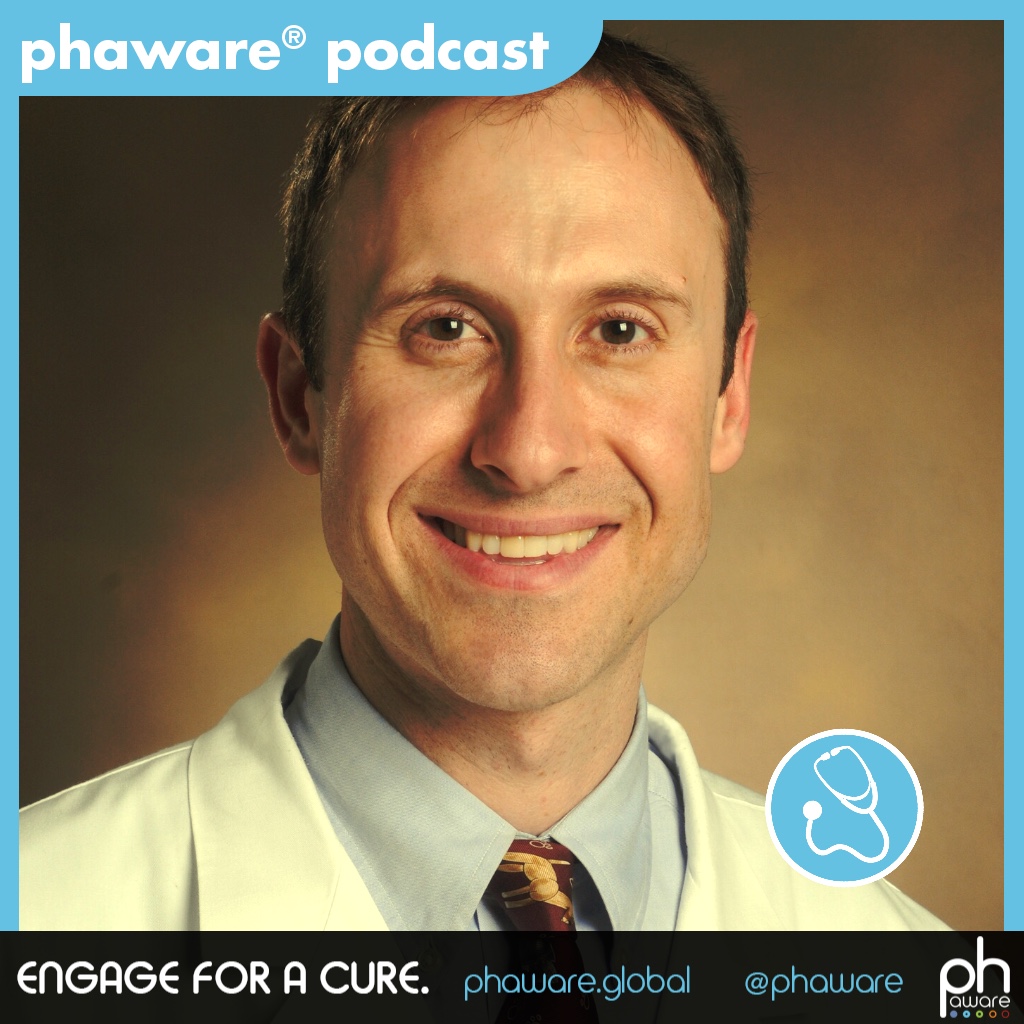Phaware Podcast: Eric Austin, MD (Part 3 of 3)

This podcast series, created and produced by phaware, is being offered as a regular guest feature on Pulmonary Hypertension News to bring the voices and life experiences of PH patients, family members, caregivers, healthcare specialists, and others to our readers. You may listen to the podcast directly, or read it via the transcript that runs below.
I’m Aware That I’m Rare: Eric Austin, MD MSCI
The phaware® interview (Episode 118)
Eric Austin is the director of the Vanderbilt Pediatric Pulmonary Hypertension (PH) Program at Vanderbilt University Medical Center’s Monroe Carell Jr. Children’s Hospital, where he treats individuals with pulmonary hypertension and other pulmonary vascular diseases. He is also a member of the adult program’s Vanderbilt Pulmonary Hypertension Clinical and Research Program, with whom he leads and/or participates in various translational research studies.
Hello, I’m Eric Austin. I’m the director of the Pulmonary Vascular Disease Program at the Vanderbilt Children’s Hospital here in Nashville, Tennessee.
Today, I’d like to talk to you about screening for pulmonary hypertension and lung disease in individuals who are related to people who have pulmonary arterial  hypertension, which is either idiopathic or heritable/familial in nature.
hypertension, which is either idiopathic or heritable/familial in nature.
Those relatives, because of genetic risk that’s higher than the population, particularly primary relatives like mother, father, and siblings, have a higher risk of PH than the rest of us in the population. It’s important to be aware of this and to correctly counsel the healthy relatives of individuals who have pulmonary arterial hypertension. The principal that we’re dealing with in this population is an openness of discussion and thoroughness of genetic counseling. What I like to do for the primary relatives of people who have, for example, idiopathic pulmonary arterial hypertension, I recommend that we see their siblings if it’s a pediatric case. And, I recommend that the parents be seen by an adult pulmonary hypertension program at least once for disease and genetic counseling.
For those children who are siblings of a pediatric case of an idiopathic pulmonary arterial hypertension but are healthy themselves, we recommend to the parents that we see the healthy child once for a physical exam and an echocardiogram in concert with genetic counseling. At that time, we recommend that they have a repeat echocardiogram and physical exam, assuming they’re healthy, every one to three years thereafter to screen for evidence of pulmonary hypertension.
Unfortunately, if it’s an idiopathic case, we do not have a lot of information about the genetic cause for that sibling to develop PAH, so we’re unable to perform genetic screening that might allow us to avoid future physical exam and echocardiograms every one to three years for the siblings of idiopathic PH cases. However, that may be different if it’s a familial or a known heritable pulmonary arterial hypertension case. The relatives of our heritable pulmonary arterial hypertension cases, who are primary relatives in particular, again, mother, father, and siblings, are at higher risk of developing arterial hypertension than the general population.
BMPR2 gene mutation
For example, the most common example of this would be a patient who has heritable pulmonary arterial hypertension due to BMPR2 gene mutation. They have siblings and parents who are at risk of having the same gene mutations, and therefore, could develop pulmonary arterial hypertension themselves at some point in their lifetime. We know that BMPR2 associated with pulmonary arterial hypertension presents at a younger age and more severely than say, for example, idiopathic pulmonary arterial hypertension. We worry a lot about the families of our BMPR2 mutation carriers who have PAH, and we think about screening those people to make sure they have not developed PAH themselves. Now, intriguingly and thankfully, not everyone who has a BMPR2 gene mutation will develop pulmonary arterial hypertension in their lifetime.
About 14 percent of males and 42 percent of females who have a BMPR2 mutation will develop PH in their lifetime. That means we need to be aware that a person can have a genetic risk of a mutation, but never actually develop the disease. In that setting, genetic counseling is incredibly important. Remember how I told you that for the siblings or the parents of idiopathic cases, I recommend a visit with the pulmonary hypertension specialist in disease and genetic counseling. That’s incredibly important for a heritable or a familial PAH case. For example, those people who have BMPR2 mutations, their mother, father, and their siblings are at risk of having the same disease because they may possess the same mutation.
When I have a patient who has a BMPR2 mutation and pulmonary arterial hypertension, I talk to their parents about bringing in the siblings to be seen. Those siblings come into the clinic and we perform disease and genetic counseling for those healthy siblings, and we recommend consideration of screening for the mutation in BMPR2 that the sick sibling has to see if it’s present in the healthy siblings. We do that with extensive discussion and counseling about what testing genetics means for that child and for the family. If the gene mutation is known, we will then proceed with BMPR2 or other directed mutation testing.
If the healthy sibling is tested and has no BMPR2 mutation that we can detect (and we already know what mutation to look for because their sibling who has PH has that mutation), that’s great news. That means that that healthy sibling is unlikely to ever develop pulmonary arterial hypertension in their lifetime. Essentially, that healthy sibling has a risk profile similar to you and me who are thankfully without a BMPR2 mutation. The first round of screening for a BMPR2 mutation family for the healthy relatives is to consider testing for that BMPR2 mutation. You would do the same for the other mutations that are known to associate with pulmonary arterial hypertension, including TBX4, HHT, and ALK1, as well as KCNK3 and CAV1.
In that setting, if the person at risk is tested and does not have the mutation, high fives all round, that person will never develop PH in their lifetime or be incredibly unlikely to develop pulmonary arterial hypertension in their lifetime. However, if that person is tested, and despite being healthy, has the family mutation present, that means that person is at risk of developing pulmonary arterial hypertension. We don’t know when. It could happen today, it could happen in 60 years, but they have a much higher risk of developing pulmonary arterial hypertension than those of us who are healthy without mutation in the population.
Screening
In that setting, we do a physical exam, echocardiogram, and electrocardiogram every year for those individuals who are healthy but at risk because of the mutation. Remember what I told you, that females have an even higher risk than the males. Despite that, we use the same yearly screening protocol, physical exam, echo and electrocardiogram for the healthy mutation carriers who are at risk. I hope that makes sense.
It’s a bit of a whirlwind, but we try to run through the notion of screening for pulmonary hypertension using non-invasive methods, which could be either mutation testing or functional like an echocardiogram or electrocardiogram. Then we talked about the notion that by doing screening, we’re hoping to detect pulmonary hypertension earlier so that we could intervene and hopefully change the trajectory of that person’s life. Either prevent them from ever expressing the disease or probably more likely make it less sever over time. We don’t actually have comprehensive data on people who have been diagnosed before symptoms and followed over time with new drugs or currently approved PH specific therapy, but we’re optimistic that over time we’ll develop that data and begin to prove that early diagnosis of people with pulmonary hypertension will lead to better outcomes.
What I’ve talked to you about today is largely an extrapolation of current expert considerations and guidelines based upon anecdotal experience more so than clinical trial data. There’s actually just a paucity of pediatric data to convincingly demonstrate benefit from earlier diagnosis. However, with regards to the discussion of idiopathic and heritable or familial pulmonary arterial hypertension cases and their relatives, we feel fairly confident that the screening of relatives of idiopathic and heritable pulmonary arterial hypertension cases should be done for those people who are primary relatives of the pulmonary hypertension patients.
Manners by which to screen include an introductory discussion of the disease in genetic counseling and pursuit of genetic testing versus directly going to echocardiogram, physical exam, and electrocardiogram testing. For those people who have a mutation in the family, genetic testing with genetic counseling performed extensively can be an incredibly beneficial tool to help avoid a lifelong survey of echocardiograms and physical exams directed to pulmonary hypertension.
My name is Eric Austin and I’m aware that I’m rare.
EVERYBODY HAS A STORY. WHAT’S YOURS?
Phaware global association wants to share your pulmonary hypertension story with their engaged global audience. Whether you are a patient, caregiver, or medical professional, they are enlisting PH community members from around the world. Visit www.phawarepodcast.libsyn.com/contact to share your story and to be considered for a future episode. Never miss an episode with the phaware® podcast app. Learn more about pulmonary hypertension at www.phaware.global. #phaware
Note: Pulmonary Hypertension News is strictly a news and information website about the disease. It does not provide medical advice, diagnosis, or treatment. This content is not intended to be a substitute for professional medical advice, diagnosis, or treatment. Always seek the advice of your physician or other qualified health provider with any questions you may have regarding a medical condition. Never disregard professional medical advice or delay in seeking it because of something you have read on this website. The opinions expressed in this column are not those of Pulmonary Hypertension News or its parent company, Bionews Services, and are intended to spark discussion about issues pertaining to pulmonary hypertension.










Leave a comment
Fill in the required fields to post. Your email address will not be published.